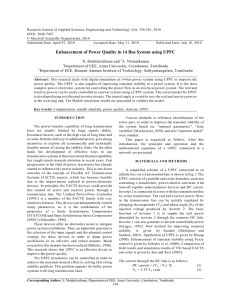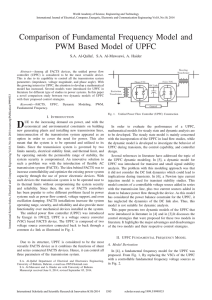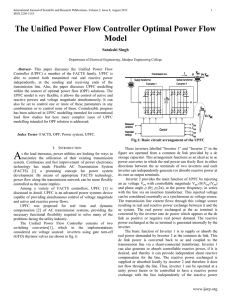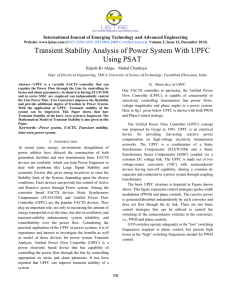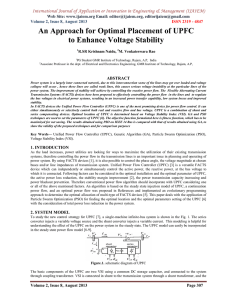International Journal of Application or Innovation in Engineering & Management... Web Site: www.ijaiem.org Email: , Volume 2, Issue 7, July 2013
advertisement
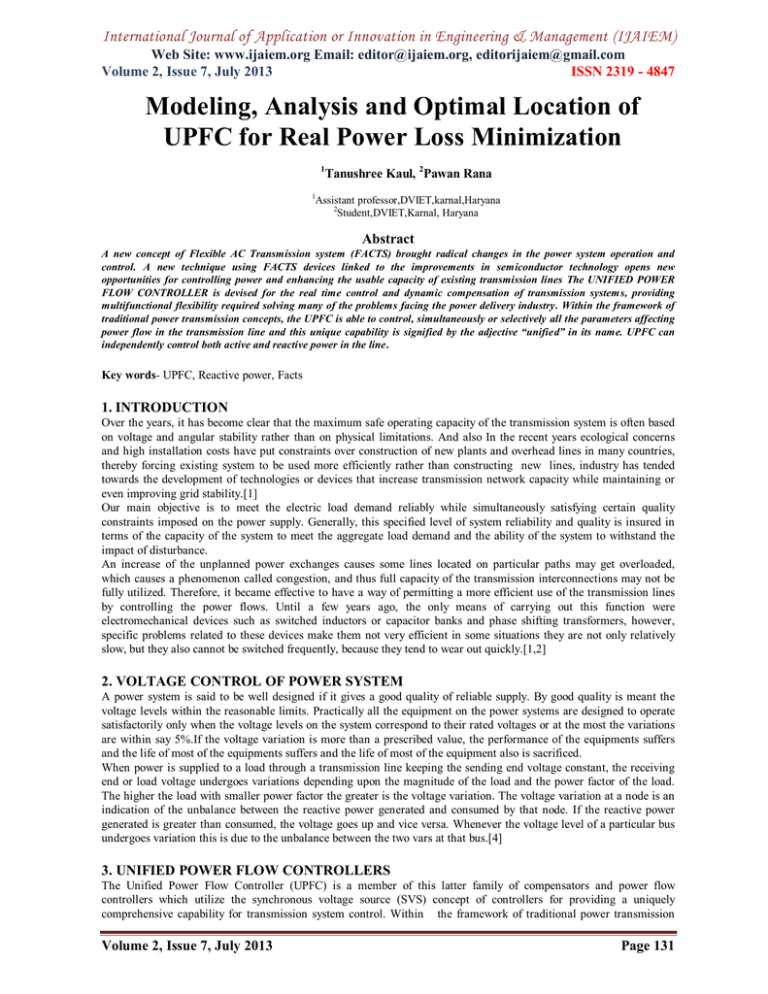
International Journal of Application or Innovation in Engineering & Management (IJAIEM) Web Site: www.ijaiem.org Email: editor@ijaiem.org, editorijaiem@gmail.com Volume 2, Issue 7, July 2013 ISSN 2319 - 4847 Modeling, Analysis and Optimal Location of UPFC for Real Power Loss Minimization 1 Tanushree Kaul, 2Pawan Rana 1 Assistant professor,DVIET,karnal,Haryana 2 Student,DVIET,Karnal, Haryana Abstract A new concept of Flexible AC Transmission system (FACTS) brought radical changes in the power system operation and control. A new technique using FACTS devices linked to the improvements in semiconductor technology opens new opportunities for controlling power and enhancing the usable capacity of existing transmission lines The UNIFIED POWER FLOW CONTROLLER is devised for the real time control and dynamic compensation of transmission systems, providing multifunctional flexibility required solving many of the problems facing the power delivery industry. Within the framework of traditional power transmission concepts, the UPFC is able to control, simultaneously or selectively all the parameters affecting power flow in the transmission line and this unique capability is signified by the adjective “unified” in its name. UPFC can independently control both active and reactive power in the line. Key words- UPFC, Reactive power, Facts 1. INTRODUCTION Over the years, it has become clear that the maximum safe operating capacity of the transmission system is often based on voltage and angular stability rather than on physical limitations. And also In the recent years ecological concerns and high installation costs have put constraints over construction of new plants and overhead lines in many countries, thereby forcing existing system to be used more efficiently rather than constructing new lines, industry has tended towards the development of technologies or devices that increase transmission network capacity while maintaining or even improving grid stability.[1] Our main objective is to meet the electric load demand reliably while simultaneously satisfying certain quality constraints imposed on the power supply. Generally, this specified level of system reliability and quality is insured in terms of the capacity of the system to meet the aggregate load demand and the ability of the system to withstand the impact of disturbance. An increase of the unplanned power exchanges causes some lines located on particular paths may get overloaded, which causes a phenomenon called congestion, and thus full capacity of the transmission interconnections may not be fully utilized. Therefore, it became effective to have a way of permitting a more efficient use of the transmission lines by controlling the power flows. Until a few years ago, the only means of carrying out this function were electromechanical devices such as switched inductors or capacitor banks and phase shifting transformers, however, specific problems related to these devices make them not very efficient in some situations they are not only relatively slow, but they also cannot be switched frequently, because they tend to wear out quickly.[1,2] 2. VOLTAGE CONTROL OF POWER SYSTEM A power system is said to be well designed if it gives a good quality of reliable supply. By good quality is meant the voltage levels within the reasonable limits. Practically all the equipment on the power systems are designed to operate satisfactorily only when the voltage levels on the system correspond to their rated voltages or at the most the variations are within say 5%.If the voltage variation is more than a prescribed value, the performance of the equipments suffers and the life of most of the equipments suffers and the life of most of the equipment also is sacrificed. When power is supplied to a load through a transmission line keeping the sending end voltage constant, the receiving end or load voltage undergoes variations depending upon the magnitude of the load and the power factor of the load. The higher the load with smaller power factor the greater is the voltage variation. The voltage variation at a node is an indication of the unbalance between the reactive power generated and consumed by that node. If the reactive power generated is greater than consumed, the voltage goes up and vice versa. Whenever the voltage level of a particular bus undergoes variation this is due to the unbalance between the two vars at that bus.[4] 3. UNIFIED POWER FLOW CONTROLLERS The Unified Power Flow Controller (UPFC) is a member of this latter family of compensators and power flow controllers which utilize the synchronous voltage source (SVS) concept of controllers for providing a uniquely comprehensive capability for transmission system control. Within the framework of traditional power transmission Volume 2, Issue 7, July 2013 Page 131 International Journal of Application or Innovation in Engineering & Management (IJAIEM) Web Site: www.ijaiem.org Email: editor@ijaiem.org, editorijaiem@gmail.com Volume 2, Issue 7, July 2013 ISSN 2319 - 4847 concepts, the UPFC is able to control, simultaneously or selectively, all the parameters affecting power flow in the transmission line (i.e., voltage impedance, and phase angle). Alternatively, it can provide the unique functional capability of independently controlling both the real and reactive power flow in the line. These basic capabilities make the most powerful device presently available for transmission system control. Figure 1 Basic circuit arrangement of UPFC 3.1 CONVENTIONAL TRANSMISSION CONTROL CAPABILITIES Viewing the operation of the Unified Power Flow Controller from the standpoint of traditional power transmission based on reactive shunt compensation, series compensation, and phase shifting, the UPFC can fulfil all these functions and thereby meet multiple control objectives by adding the injected voltage Vpq, with appropriate amplitude and phase angle, to the (sending-end) terminal voltage Vs. Voltage regulation with continuously variable in-phase anti-phase voltage injection, shown at ‘a’ for voltage increments Vpq= ±Δv(ρ=0). Functionally this is similar to that obtainable with a transformer tap-changer having infinitely small steps. Series reactive compensation is shown at b where Vpq=Vσ is injected in quadrature with the line current I. Functionally this is similar to, but more general than the controlled series capacitive and inductive line compensation. This is because the UPFC injected series compensating voltage can be kept constant, if desired, independent of line current variation, whereas the voltage across the series compensating impedance varies with the line current. 3.2 MODELING OF UPFC The voltage at the bus i is taken as reference (all other angles are taken wrt this bus angle) Vi = |V|0 (1) And voltage upto UPFC is Vi’=Vi+Vse. The voltage sources,Vse and Vsh,are controllable in both magnitude and phase angles. the values of and r are defined with in the limits as 0 r rmax 0 2 Figure 2 Two voltage source model of UPFC Vse is defined in terms of reference bus voltage (i.e) ,Vi. Vse= r*Vi *e^(j) (2) For finding the power fed by the UPFC we go for superposition theorem. first considering the series voltage source and then the shunt one. By considering the series source the circuit is as below The steady-state UPFC mathematical model is developed by replacing Vse by a current source using duality principle. Which is connected in parallel with the transmission line, where bse =1/Xse. Ise = -j*bse*Vse (3) The convention for flow of current is if the current leaves the node it is negative and if it enters the node it is positive Figure 3 Replacement of voltage source by current source Volume 2, Issue 7, July 2013 Page 132 International Journal of Application or Innovation in Engineering & Management (IJAIEM) Web Site: www.ijaiem.org Email: editor@ijaiem.org, editorijaiem@gmail.com Volume 2, Issue 7, July 2013 ISSN 2319 - 4847 As the power is equal to the product of voltage and current conjugate P+jQ = Vj*(I˜). (4) Sis = Vi(-Ise)˜ ( ˜ refers conjugate of the variable ) (5) Sjs= Vj (I) (6) The injected powers Sis Sjs can be simplified according to following operations Sis = Vi ( jbse r Vi e^ (j))˜. (7) From eulers identity e^(j) = cos+jsin. Sis= Vi( e^(-j (+90) х bse х r Vi˜). (8) So Sis= -r х bse х Vi ² [cos(--90)+ j sin (--90)] As cos(--90)=-sin sin (--90)=-cos. Sis = -r bse Vi²sin-j bse r Vi²cos (9) Since Sis=Pis+jQis Comparing above equations Pis= -r bse Vi² sin . (10) Qis=-r bse Vi² cos . (11) The voltage Vj=Vjθj and Vi= Viθi Sjs=Vj(Ise)˜ Sjs=Vjθj(-j bse r Vi θi e^(j)) (12) Sjs= Vi Vj bse r sin(θi-θj+)+j I Vj bse r cos(θi-θj+). And Sjs= Pjs+Qjs. Comparing above equations we get Pjs= Vi Vj bse r sin(θi-θj+) (13) Qjs= Vi Vj bse r cos(θi-θj+) (14) Now we will consider the shunt source, in UPFC, the shunt branch is used mainly to provide both the real power, Pse, which is injected to the system through the series branch, and the total losses within the UPFC. The total switching losses of the two converters is estimated to be about 2% of power transferred ,for Thyristor based PWM converters, if losses are included in real power injection of shunt connected voltage source at bus I , Psh is equal to 1.02 times the injected series real power through the series connected voltage source to the system. Psh = -1.02 Pse Fig 4 Steady state mathematical model 4. IMPLEMENTATION ON IEEE-14 BUS SYSTEM Volume 2, Issue 7, July 2013 Page 133 International Journal of Application or Innovation in Engineering & Management (IJAIEM) Web Site: www.ijaiem.org Email: editor@ijaiem.org, editorijaiem@gmail.com Volume 2, Issue 7, July 2013 ISSN 2319 - 4847 5. RESULTS Table 1: Power flows for IEEE-14 bus system with UPFC Active power flow Reactive power flow Line no. (MW) (MVAR) 1 1.5696 -0.2042 2 0.7334 0.03549 3 0.5609 -0.0045 4 0.7544 0.0441 5 0.04152 0.019 6 -0.2318 0.0463 7 -0.6106 0.1269 8 0.4412 0.1191 9 0.2805 -0.1028 10 0 -0.1774 11 0.1606 -0.0067 12 0.2805 0.5732 13 0.052 0.0401 14 0.0737 0.0376 15 0.0779 0.0252 16 0.1776 0.0732 17 0.094 0.0347 18 -0.038 -0.0181 19 0.0162 0.0077 20 0.0566 0.0187 Table 2 Power flows for IEEE-14 bus system without placing UPFC Line no. 1 2 3 4 5 6 7 8 9 10 11 12 13 14 15 16 17 18 19 20 Active power (MW) 1.557 0.69 0.54 0.788 0.392 -0.273 -0.679 0.445 0.28 -5.16E-17 0.156 0.28 0.049 0.076 0.078 0.179 0.092 -0.041 0.017 0.059 Reactive power (MVAR) -0.201 0.04 -0.367 -0.291 -0.398 -0.317 -0.066 -0.156 -0.522 -0.721 -0.15 0.139 0.034 0.043 0.026 0.075 0.031 -0.024 0.008 0.022 The efficiency of the method is tested on IEEE 14- bus and 9-bus system. The optimal parameter of UPFC are evaluated which minimizes the system losses, fixing the location of line in which UPFC is placed. Power flows through lines also obtained. This process is carried out for all the lines. The line in which total losses are minimum is the optimal location. Each test system is studied for two cases. For 14-bus system optimal location is done at base case and Volume 2, Issue 7, July 2013 Page 134 International Journal of Application or Innovation in Engineering & Management (IJAIEM) Web Site: www.ijaiem.org Email: editor@ijaiem.org, editorijaiem@gmail.com Volume 2, Issue 7, July 2013 ISSN 2319 - 4847 1.3 times the base load and for the 9-bus system optimal location is done at at base case and 1.1 times the base load. The losses are 30% less than the others power system control method. 6. CONCLUSIONS In this study, an improved UPFC steady-state mathematical model for the implementation of the device in the conventional NR power flow algorithm has been developed from a two-voltage source equivalent of UPFC. An advantage of the model is that the model is capable of taking the losses of UPFC into account. References [1.] “FACTS Overview”, IEEE Power Engineering Society/Cigre, IEEE Service Center, Piscataway, N.J., 1995, SpecialIssue, 95TP108. [2.] A. Edris, “FACTS Technology Development: An Update”, IEEE Power Engineering Review, March 2000, p. 4. [3.] L. Gyugyi, C.D. Schauer, S.L. Williams, T.R. Rietman, D.R. Torgerson, and A. Edris, “The Unified Power Flow Controller: A New Approach to Power Transmission Control. [4.] A. Edris, A.S. Mehraban, M. Rahman, L. Gyugyi, S. Arabi, and T. Reitman, “Controlling The Flow Of Real And Reactive Power”, IEEE Computer Applications In Power, January 1998, p. 20. [5.] R. J. Nelson, J. Bian, and S. L. Williams, “Transmission Series Power Flow Control”, IEEE Trans. On Power Delivery, 10 (1) (1995), p. 504. [6.] Laszlo Gyugyi, “Solid-State Synchronous Voltage Sources for Dynamic Compensation And Real-Time Control of ACTransmission Lines”, in Emerging Practices In Technology, New York: IEEE Standards Press, 1993, p. 1. [7.] L. Xu and V.G. Agelidis, “Flying Capacitor Multilevel PWM Converter Based UPFC‟, IEE Proc. Of Electronic Power Application,Vol. 149, No. 4, July 2003. Page(s) 304-310. [8.] Narain G. Hingorani, Laszlo Gyugyi, “Understanding FACTS: Concepts and Technology of Flexible AC Transmission Systems,”IEEE Press Marketing, 1999, pp. 297-352, pp. 407-424. [9.] C. D. Schauder, D.M. Hamai, A. Edris, “Operation of the Unified Power Controller (UPFC) under practical constraints”, IEEE transaction on Power Delivery, vol. 13, No. 2, April 1998. [10.] I. Papic, P. Zunko, D. Povh, “Basic control of Unified Power Flow Controller” IEEE Trans. on Power Systems, Vol. 12, No. 4, November [11.] Power World Simluator v2.0- Glover & sarma, power system Analysis. AUTHOR Pawan Rana receeived the B.tech degree in electrical & electronics engg. From Doon valley institute of engg. & Tech. Karnal ,Haryana Yr. 2010. Presently purusuing M.tech in electrical & electronics engg. From Doon valley institute of engg. & Tech . & working as a lecturer in EE Deptt. at RPIIT TECHNICAL CAMPUS karnal , Haryana . Volume 2, Issue 7, July 2013 Page 135







